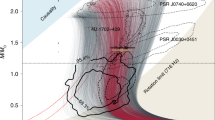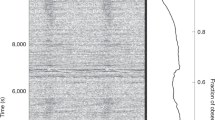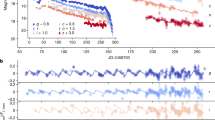Abstract
OUR Galaxy should contain between a hundred million and a billion neutron stars; this follows from an extrapolation of pulsar birthrates1 and from the number of supernovae required to account for the heavy-element abundances in the Milky Way2. Only about 600 pulsars are known3; some fraction of neutron stars will not be beaming in our direction, and therefore will not be detectable as pulsars, and some will be sufficiently old that they have stopped pulsating. How many old neutron stars exist is unknown, but based on the above numbers, about 2,000 isolated ones (not in binary systems) should be detectable as hot thermal sources, emitting X-rays as their surfaces cool or as they accrete gas from the interstellar medium4–7. To date, however, evidence for only one has been presented8, and its identification is ambiguous. Here we show that a bright soft-X-ray source has the properties of an isolated neutron star at a distance of about 100 parsecs. Although this confirms our present understanding of how isolated neutron stars should appear, it also highlights the significant problem of accounting for the absence of the others that should be visible.
This is a preview of subscription content, access via your institution
Access options
Subscribe to this journal
Receive 51 print issues and online access
$199.00 per year
only $3.90 per issue
Buy this article
- Purchase on Springer Link
- Instant access to full article PDF
Prices may be subject to local taxes which are calculated during checkout
Similar content being viewed by others
References
Narayan, R. & Ostriker, J. P. Astrophys. J. 352, 222–246 (1990).
Arnett, W. D., Schramm, D. N. & Truran, J. W. Astrophys. J. 339, L25–L27 (1989).
Phinney, E. S. & Kulkarni, S. R. A. Rev. Astr. Astrophys. 32, 591–639 (1994).
Ostriker, J. P., Rees, M. J. & Silk, J. Astrophys. Lett. 6, 179–184 (1970).
Helfand, D. J., Chanan, G. A. & Novick, R. Nature 283, 337–343 (1980).
Treves, A. & Colpi, M. Astr. Astrophys. 241, 107–111 (1991).
Blaes, O. & Madau, P. Astrophys. J. 403, 690–705 (1993).
Stocke, J. T., Wang, Q. D., Perlmar, E. S., Donahue, M. E. & Schachter, J. Astr. J. 109, 1199–1203 (1995).
Trümper, J. Adv. Space Res. 2, 241–249 (1983).
Pfeffermann, E. et al. in Soft X-Ray Optics and Technology (eds Koch, E.-E. & Schmahl, G.) 519–557 (Proc. SPIE Vol. 733, SPIE: Bellingham WA, 1987).
Aschenbach, B. Bull. appl. Opt. 27, 1404–1413 (1988).
Walter, F. M. in The Soft X-Ray Cosmos (eds Schlegel, E. M. & Petre, R.) 263–265 (AIP Conf. Proc. 313, Am. Inst. Phys., New York, 1994).
Plummer, D., Schacter, J., Garcia, M. & Elvis, M. The EINSTEIN Observatory IPC Slew Survey CD-ROM (Center for Astrophysics, Cambridge MA, 1991).
Snowden, S. L. et al. Status of the PSPC Spatial/Temporal Gain Calibration (OGIP Calibration Memo CAL/ROS/95-003, NASA Goddard Space Flight Center, Washington. DC, 1995).
Nugent, J. et al. Astrophys. J. Suppl. Ser. 51, 1–28 (1983).
Pye, J. et al. Mon. Not. R. astr. Soc. 274, 1165–1193 (1995).
Malina, R. F. et al. Astr. J. 107, 751–764 (1994).
Perlman, E. S. et al. Astrophys. J. Suppl. Ser. (submitted).
Wang, Q. D. in The Soft X-Ray Cosmos (eds Schlegel, E. M. & Petre, R.) 301–305 (AIP Conf. Proc. 313, Am. Inst. Phys., New York, 1994).
Lepp, S. & McCray, R. Astrophys. J. 269, 560–567 (1983).
White, N. E. & Marshall, F. E. Astrophys. J. 281 354–359 (1984).
Page, D. & Applegate, J. H. Astrophys. J. 394, L17–L20 (1993).
Lattimer, J. M., van Riper, K. A., Prakash, M. & Prakash, M. Astrophys. J. 425, 802–813 (1994).
Reisenegger, A. Astrophys. J. 442, 749–757 (1995).
Colpi, M., Campana, S. & Treves, A. Astr. Astrophys. 278, 161–166 (1993).
Blaes, O., Warren, O. & Madau, P. Astrophys. J. (in the press).
Zampieri, L., Turolla, R., Zane, S. & Treves, A. Astrophys. J. 439, 849–853 (1995).
Shemi, A. Mon. Not. R. astr. Soc. (in the press).
Landolt, A. U. Astr. J. 104, 340–371 (1992).
Nelson, R.W., Wang, J. C. L., Salpeter, E. E. & Wasserman, I. Astrophys. J. 438, L99–102 (1995).
Author information
Authors and Affiliations
Rights and permissions
About this article
Cite this article
Walter, F., Wolk, S. & Neuhäuser, R. Discovery of a nearby isolated neutron star. Nature 379, 233–235 (1996). https://doi.org/10.1038/379233a0
Received:
Accepted:
Issue Date:
DOI: https://doi.org/10.1038/379233a0
This article is cited by
-
The nearest neutron star candidate in a binary revealed by optical time-domain surveys
Science China Physics, Mechanics & Astronomy (2023)
-
Neutron stars as probes of extreme energy density matter
Pramana (2015)
-
Neutron stars and the dense matter equation of state
Astrophysics and Space Science (2011)
-
Towards self-consistent models of isolated neutron stars
Astrophysics and Space Science (2007)
-
The magnificent seven: magnetic fields and surface temperature distributions
Astrophysics and Space Science (2007)
Comments
By submitting a comment you agree to abide by our Terms and Community Guidelines. If you find something abusive or that does not comply with our terms or guidelines please flag it as inappropriate.



